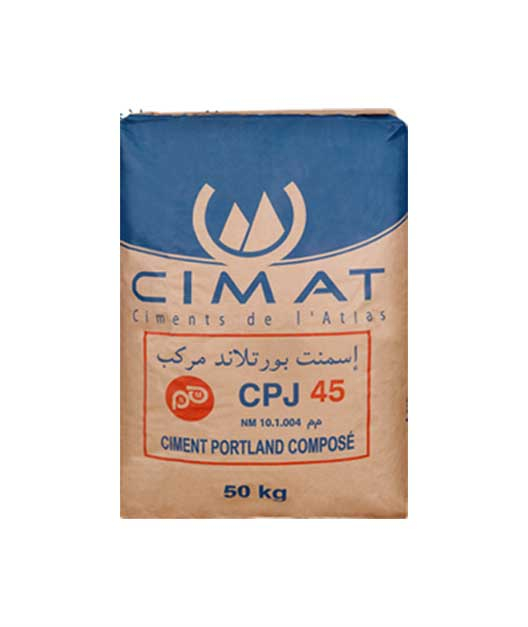Our cements
Building Cements

CEMENT CPJ 35
CPJ 35 CIMAT is a composite portland cement whose main constituents are clinker, limestone filler and gypsum.
Its resistance class makes it particularly suitable for the manufacture of mortars and plasters for masonry, as well as unreinforced concrete with low mechanical resistance.
CIMAT's CPJ 35 cement complies with all the chemical, physical and mechanical requirements of the Moroccan standard NM 10.1.004
CPJ 35 cement is only intended for the realization of mortars and unreinforced concretes.
CPJ 35 cement is only intended for the realization of mortars and unreinforced concretes.
- Masonry: Alone or in a bastard mixture, this cement can be used for common masonry work (laying and jointing of blocks, bricks and stones).
- Plasters: Can be used to make exterior and interior plasters.
- Tile: This cement is indicated for the realization of the layer of form and the screed of installation and jointing of the tiles.
The success of the work undertaken with this cement remains, of course, conditioned by the respect of the rules of good practice in matters of preparation, implementation and conservation of mortars and concretes
- Once in the warehouse or on site, the bags should be stored in a dry place and on a surface protected from any form of humidity.
- To limit the time bags stay in storage, always use the first ones stored.
- The quality of concrete and mortar also depends on the quality of the other ingredients, so select and use aggregates and sands that are free of impurities.
- When making your concrete and mortar, pay particular attention to the water content.
- Excess water alters the quality of concrete and mortar.
- During periods of low temperature, the increase of cement dosages is of great help to guarantee a normal hardening of concretes and mortars.
- Avoid contact with skin and eyes.
- Use appropriate equipment: gloves, waterproof shoes and safety glasses.
 Download the technical sheet
Download the technical sheet

CPJ 45 - BAG 50 KG
CPJ 45 CIMAT is a hydraulic binder that can be used in virtually all forms of concrete structures. This product meets all the chemical, physical and mechanical requirements of NM 10.1.004
This Portland cement is the result of the grinding of:
- Clinker in a proportion greater than or equal to 65%.
- 100% complement of one or more additions such as limestone or fly ash.
CPJ 45 CIMAT is a construction material that can be used in a wide range of commercial and architectural concrete structures. It can be used in:
- Ready-mixed concrete.
- Highly stressed reinforced concrete (load-bearing structures).
- Ordinary works in reinforced concrete.
- Large-scale works.
- Precast unreinforced concrete products.
- Soil stabilization.
- Cement treated gravel.
The success of the works undertaken with this cement remains, of course, conditioned by the respect of the rules of good practice in matters of preparation, implementation and conservation of mortars and concretes.
- Once in the warehouse or on site, the bags should be stored in a dry place and on a surface protected from any form of humidity.
- To limit the time bags stay in storage, always use the first ones stored.
- The quality of concrete and mortar also depends on the quality of the other ingredients, so select and use aggregates and sands that are free of impurities.
- When making your concrete and mortar, pay particular attention to the water content. Excess water alters the quality of concrete and mortar.
- The use of additives is governed by well-defined rules, so consult a specialist before using them.
- After the application of concrete and mortar, cure the surfaces by wetting for at least two days after application, especially in hot weather.
- During periods of low temperature, the increase of cement dosages is of great help to guarantee a normal hardening of concretes and mortars.
- Avoid contact with skin and eyes.
- Use appropriate equipment: gloves, waterproof shoes and safety glasses.
 Download the technical sheet
Download the technical sheet

